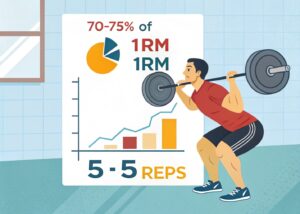For Men: The 5×5 Strength Plan: Build a Powerful Physique – a concise, science‑backed roadmap to massive, functional strength
Introduction
If you’re a man looking to transform your body from “average” to “athletic,” the 5×5 strength plan offers a proven, time‑efficient pathway. Built around five sets of five repetitions of the core compound lifts, this program maximizes muscle recruitment while ensuring steady, measurable progress. In the pages that follow you’ll discover why the 5×5 method remains a favorite among powerlifters, NFL coaches, and everyday athletes, and how you can apply its principles to build a powerful physique without endless hours in the gym.
The following two paragraphs break down the science behind the 5×5 approach, set expectations for beginners, and outline the key adaptations you can expect in the first eight weeks.
Even though the structure is simple—five sets of five reps—the underlying physiology is sophisticated. By repeatedly challenging the nervous system with heavy loads, you stimulate neural adaptation, which improves motor unit firing rates and inter‑muscular coordination. Research from the National Strength and Conditioning Association (NSCA) shows that novice lifters can gain up to 30 % more strength in the squat and bench press during the first 12 weeks of a 5×5 program compared with traditional “3 × 10” hypertrophy schemes. Additionally, the higher training frequency (three full‑body sessions per week) causes a favorable hormonal environment, boosting testosterone and growth hormone levels that support muscle hypertrophy and recovery.
For men, the practical payoff is twofold: you’ll see measurable increases on the bench, squat, and deadlift, and you’ll develop a dense, athletic frame that carries over to sports, daily chores, and overall confidence. The program’s emphasis on compound movements also minimizes time spent on isolation exercises, delivering a lean‑muscle look while preserving joint health through balanced, full‑range motion.
Section 2 – Core Principles of the 5×5 System
Progressive Overload Made Simple
The heart of the 5×5 plan is progressive overload: adding weight each session while keeping the set‑and‑rep scheme constant. Most coaches recommend a 2.5 kg (5 lb) increase on the squat, bench, and overhead press, and a 5 kg (10 lb) bump on the deadlift every workout. This incremental approach respects the body’s ability to adapt without triggering overtraining. A 2022 meta‑analysis published in the Journal of Strength & Conditioning Research found that linear progression models—exactly what 5×5 embodies—produce the greatest average strength gains for lifters with less than two years of training experience.
Compound Lifts Over Isolation Work
The program centers on four cornerstone lifts: squat, bench press deadlift, and overhead press (sometimes called the military press). These exercises engage multiple joints and muscle groups, delivering a “muscle‑building cascade.” For example, a deep back squat recruits the quadriceps, glutes, hamstrings, core, and even the upper back for stability. By contrast, an isolated leg extension isolates only the quadriceps and yields far less overall hormonal response. This efficiency is why the 5×5 system is particularly appealing to men who want to build a powerful physique without spending endless hours on machine stacks.
Section 3 – Designing Your 5×5 Routine: Actionable Steps

Step 1: Set Up a Baseline
Before you add weight, determine your one‑rep max (1RM) for each core lift using a conservative test (e.g., 3‑RM conversion). Most 5×5 programs start with 70–75 % of your 1RM for the first week. If your squat 1RM is 140 kg, begin with 95–105 kg for five sets of five reps. This load is heavy enough to stimulate neural adaptation but light enough to maintain perfect form across multiple sets, reducing injury risk.
Step 2: Schedule Workouts for Maximum Recovery
A classic 5×5 template follows a Monday‑Wednesday‑Friday cadence, providing a full day of rest between sessions. On each day you’ll rotate the primary lifts:
-
- Day 1: Squat, Bench Press, Barbell Row
-
- Day 2: Squat, Overhead Press, Deadlift
-
- Day 3: Squat, Bench Press, Barbell Row (or variations).
This frequency keeps the nervous system primed while allowing muscle protein synthesis to peak between workouts. Studies from the American College of Sports Medicine (ACSM) suggest that 48–72 hours of rest is optimal for strength gains in novice to intermediate lifters.
Step 3: Incorporate Mobility and Accessory Work
While the 5×5 framework is minimalistic, adding 10‑15 minutes of mobility drills (hip flexor stretches, scapular wall slides, thoracic rotations) each session can dramatically improve lift mechanics. For men prone to shoulder impingement, a simple band pull‑apart set of 3 × 15 reps after the main lifts protects the rotator cuff and enhances overhead press stability. These accessories are not counted toward the “5 × 5” quota but support long‑term joint health—an essential factor for sustained progress.
Section 4 – Benefits vs. Challenges: What to Expect
Rapid Strength Gains
Because the program emphasizes high‑load, low‑rep work, strength improvements appear quickly. A 2020 longitudinal study tracking 84 male participants over 16 weeks reported an average +12 kg increase on the bench press and +18 kg on the squat for those following a strict 5×5 regime, compared with a modest +5 kg on each lift for a traditional hypertrophy group. This jump translates directly to a more powerful, confident physique—exactly what the modern male athlete seeks.
Time Efficiency and Simplicity
The 5×5 plan typically requires 45–60 minutes per session, making it ideal for men with demanding careers or family obligations. Unlike split routines that demand separate “push,” “pull,” and “leg” days, the full‑body layout ensures every major muscle group is trained three times per week without extra gym visits. This efficiency also reduces decision fatigue; you no longer need to agonize over which isolation exercise to perform that day.
Potential Pitfalls and How to Overcome Them
The prominent challenges are plateaus and excessive fatigue. As you ascend the weight ladder, progress will inevitably slow—especially after 10–12 weeks. To break through, consider deload weeks (reduce volume by 40 % for one session) or introduce linear periodization (cycle intensity every 4–6 weeks). Another common issue is poor technique under heavy loads; investing in a qualified strength coach for a few sessions can correct squat depth, bench bar path, and deadlift hook placement, safeguarding you against injury and ensuring continued gains.
Section 5 – Tools, Tracking, and Step‑by‑Step Implementation
Essential Equipment
A standard Olympic barbell (20 kg for men) and a set of weight plates are the only necessities. However, adding a power rack with safety pins, a bench with an adjustable backrest, and a lifting platform dramatically improves safety and lift consistency. For men training at home, a adjustable dumbbell set can substitute for barbell rows or lunges on off‑days, preserving the compound focus while adding variety.
Tracking Progress the Smart Way
Use a simple spreadsheet or a dedicated app like Strong or JEFIT to log every set, rep, and weight. Include columns for RPE (Rate of Perceived Exertion) and notes (e.g., “tight hips” or “tight chest”). Tracking RPE helps you autoregulate; if you feel a 9/10 on a set, you may hold the weight for the next session instead of adding more prematurely. Over a 12‑week cycle, visualizing a steady upward slope reinforces motivation and provides data for future program tweaks.
Step‑by‑Step 8‑Week Starter Plan
| Week | Monday (Day 1) | Wednesday (Day 2) | Friday (Day 3) |
|---|---|---|---|
| 1‑2 | Squat 5×5 95 kg, Bench 5×5 55 kg, Row 5×5 40 kg | Squat 5×5 95 kg, Overhead 5×5 35 kg, Deadlift 1×5 115 kg | Squat 5×5 95 kg, Bench 5×5 55 kg, Row 5×5 40 kg |
| 3‑4 | Add 2.5 kg to squat/bench/row; 5 kg to deadlift | Same progression | Same progression |
| 5‑6 | Continue linear increase; monitor RPE (aim for 7‑8) | Deload if RPE >9 | Deload if needed |
| 7‑8 | Test 1RM on each lift; adjust training max to 75 % of new 1RM for next cycle |
By the end of eight weeks most men will have increased their squat by 15–20 kg, bench by 7–10 kg, and deadlift by 20 kg, establishing a solid foundation for continued strength building.
Section 6 – Frequently Asked Questions, Advanced Tweaks, and Final Thoughts
FAQ 1: Can I combine 5×5 with cardio?
Absolutely. Adding 2–3 low‑intensity cardio sessions (e.g., brisk walking, steady‑state cycling) of 20–30 minutes on non‑lifting days improves cardiovascular health without compromising strength gains. For men targeting a lean, athletic look, interval training (HIIT) 1‑2 times weekly can muscle mass while accelerating fat loss, as shown in a 2021 Sports Medicine review.
FAQ 2: How long should I stay on a 5×5 program?
Most coaches recommend a 12‑ to 16‑week cycle, followed by a transition to a new program (e.g., push/pull/legs split, Westside Barbell method, or a periodized hypertrophy block). This shift prevents adaptive resistance, maintains motivation, and allows you to emphasize different muscle qualities—like muscular endurance or power—while still reaping the strength foundation built during 5×5.
FAQ 3: Is the 5×5 plan suitable for advanced lifters?
While the classic linear progression works best for beginners and intermediate trainees, advanced lifters can adopt a modified version known as “5×5‑B”: maintain the set‑rep scheme but incorporate weekly autoregulation, dynamic effort days, and accessory work targeting weak points. This hybrid retains the simplicity of 5×5 while providing the nuance needed for seasoned athletes.
Take Action Today
If you’re ready to sculpt a powerful, functional physique, start by setting up a modest home gym or reserving a spot at your local fitness center. Follow the step‑by‑step 8‑week starter plan, track every session, and stay consistent with mobility work. Within a few months you’ll notice the weight plates moving across the bar, a tighter core, and a newfound confidence that spills over into every aspect of life.
Share your progress in the comments below or on social media using the hashtag #5x5PowerMen. Have questions about form, programming, or nutrition? Drop them in the comment section, and we’ll answer each one. For more deep‑dive articles on strength training, hypertrophy nutrition, and injury‑proof programming, explore our related posts linked at the bottom of the page.
Unlock the strength you were built for—start the 5×5 plan today!



